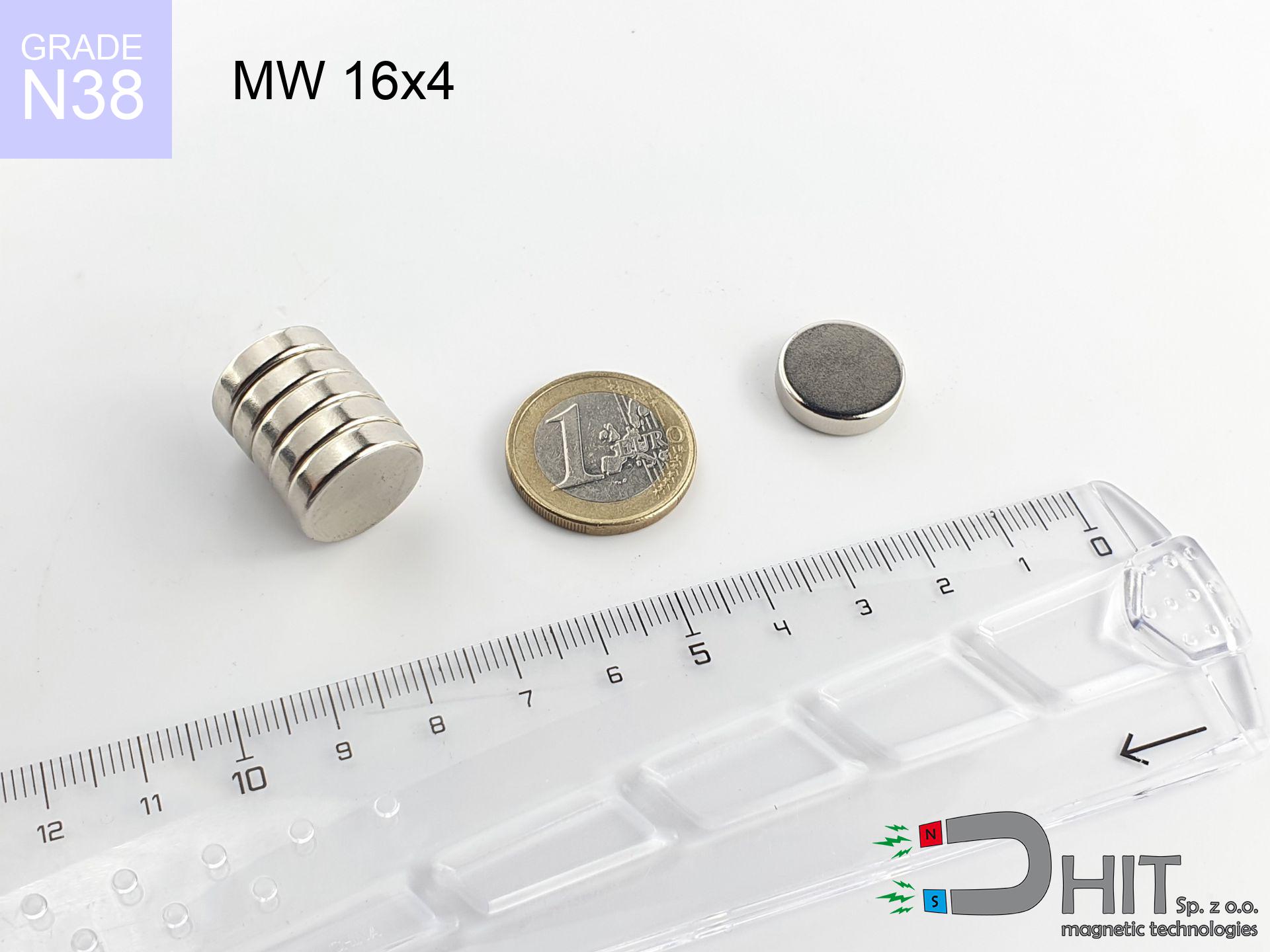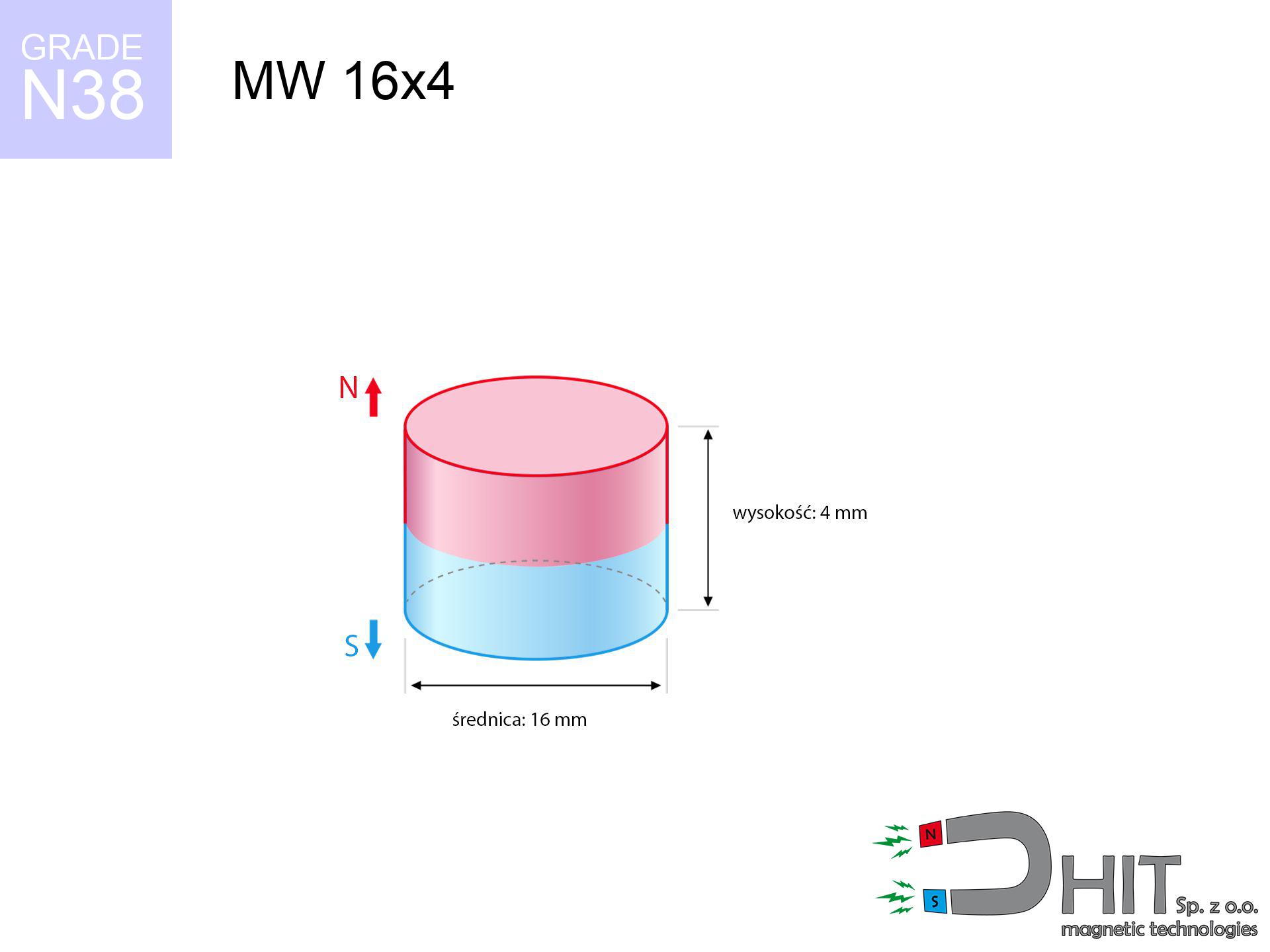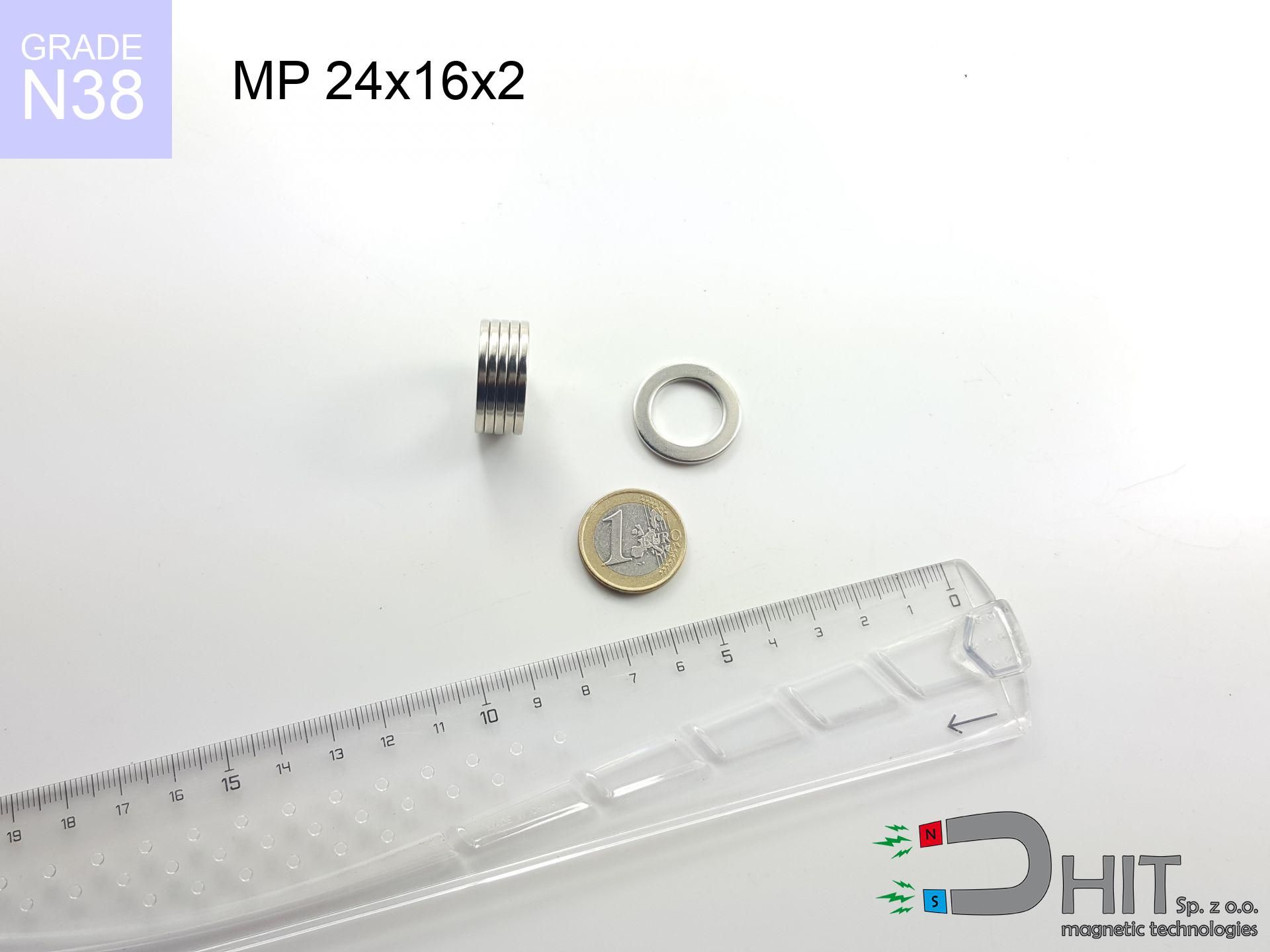MW 16x4 / N38 - cylindrical magnet
cylindrical magnet
Catalog no 010034
GTIN/EAN: 5906301810339
Diameter Ø
16 mm [±0,1 mm]
Height
4 mm [±0,1 mm]
Weight
6.03 g
Magnetization Direction
↑ axial
Load capacity
4.43 kg / 43.46 N
Magnetic Induction
277.14 mT / 2771 Gs
Coating
[NiCuNi] Nickel
3.39 ZŁ with VAT / pcs + price for transport
2.76 ZŁ net + 23% VAT / pcs
bulk discounts:
Need more?
Call us
+48 22 499 98 98
alternatively contact us using
inquiry form
our website.
Force as well as structure of magnets can be reviewed on our
modular calculator.
Order by 14:00 and we’ll ship today!
Product card - MW 16x4 / N38 - cylindrical magnet
Specification / characteristics - MW 16x4 / N38 - cylindrical magnet
| properties | values |
|---|---|
| Cat. no. | 010034 |
| GTIN/EAN | 5906301810339 |
| Production/Distribution | Dhit sp. z o.o. |
| Country of origin | Poland / China / Germany |
| Customs code | 85059029 |
| Diameter Ø | 16 mm [±0,1 mm] |
| Height | 4 mm [±0,1 mm] |
| Weight | 6.03 g |
| Magnetization Direction | ↑ axial |
| Load capacity ~ ? | 4.43 kg / 43.46 N |
| Magnetic Induction ~ ? | 277.14 mT / 2771 Gs |
| Coating | [NiCuNi] Nickel |
| Manufacturing Tolerance | ±0.1 mm |
Magnetic properties of material N38
| properties | values | units |
|---|---|---|
| remenance Br [min. - max.] ? | 12.2-12.6 | kGs |
| remenance Br [min. - max.] ? | 1220-1260 | mT |
| coercivity bHc ? | 10.8-11.5 | kOe |
| coercivity bHc ? | 860-915 | kA/m |
| actual internal force iHc | ≥ 12 | kOe |
| actual internal force iHc | ≥ 955 | kA/m |
| energy density [min. - max.] ? | 36-38 | BH max MGOe |
| energy density [min. - max.] ? | 287-303 | BH max KJ/m |
| max. temperature ? | ≤ 80 | °C |
Physical properties of sintered neodymium magnets Nd2Fe14B at 20°C
| properties | values | units |
|---|---|---|
| Vickers hardness | ≥550 | Hv |
| Density | ≥7.4 | g/cm3 |
| Curie Temperature TC | 312 - 380 | °C |
| Curie Temperature TF | 593 - 716 | °F |
| Specific resistance | 150 | μΩ⋅cm |
| Bending strength | 250 | MPa |
| Compressive strength | 1000~1100 | MPa |
| Thermal expansion parallel (∥) to orientation (M) | (3-4) x 10-6 | °C-1 |
| Thermal expansion perpendicular (⊥) to orientation (M) | -(1-3) x 10-6 | °C-1 |
| Young's modulus | 1.7 x 104 | kg/mm² |
Technical modeling of the magnet - report
These values are the direct effect of a physical simulation. Values were calculated on algorithms for the class Nd2Fe14B. Actual conditions may differ. Treat these data as a reference point for designers.
Table 1: Static pull force (pull vs gap) - interaction chart
MW 16x4 / N38
| Distance (mm) | Induction (Gauss) / mT | Pull Force (kg) | Risk Status |
|---|---|---|---|
| 0 mm |
2771 Gs
277.1 mT
|
4.43 kg / 4430.0 g
43.5 N
|
medium risk |
| 1 mm |
2517 Gs
251.7 mT
|
3.66 kg / 3656.3 g
35.9 N
|
medium risk |
| 2 mm |
2216 Gs
221.6 mT
|
2.83 kg / 2834.9 g
27.8 N
|
medium risk |
| 3 mm |
1906 Gs
190.6 mT
|
2.10 kg / 2096.1 g
20.6 N
|
medium risk |
| 5 mm |
1348 Gs
134.8 mT
|
1.05 kg / 1048.6 g
10.3 N
|
weak grip |
| 10 mm |
542 Gs
54.2 mT
|
0.17 kg / 169.4 g
1.7 N
|
weak grip |
| 15 mm |
244 Gs
24.4 mT
|
0.03 kg / 34.2 g
0.3 N
|
weak grip |
| 20 mm |
125 Gs
12.5 mT
|
0.01 kg / 9.1 g
0.1 N
|
weak grip |
| 30 mm |
45 Gs
4.5 mT
|
0.00 kg / 1.1 g
0.0 N
|
weak grip |
| 50 mm |
11 Gs
1.1 mT
|
0.00 kg / 0.1 g
0.0 N
|
weak grip |
Table 2: Vertical capacity (vertical surface)
MW 16x4 / N38
| Distance (mm) | Friction coefficient | Pull Force (kg) |
|---|---|---|
| 0 mm | Stal (~0.2) |
0.89 kg / 886.0 g
8.7 N
|
| 1 mm | Stal (~0.2) |
0.73 kg / 732.0 g
7.2 N
|
| 2 mm | Stal (~0.2) |
0.57 kg / 566.0 g
5.6 N
|
| 3 mm | Stal (~0.2) |
0.42 kg / 420.0 g
4.1 N
|
| 5 mm | Stal (~0.2) |
0.21 kg / 210.0 g
2.1 N
|
| 10 mm | Stal (~0.2) |
0.03 kg / 34.0 g
0.3 N
|
| 15 mm | Stal (~0.2) |
0.01 kg / 6.0 g
0.1 N
|
| 20 mm | Stal (~0.2) |
0.00 kg / 2.0 g
0.0 N
|
| 30 mm | Stal (~0.2) |
0.00 kg / 0.0 g
0.0 N
|
| 50 mm | Stal (~0.2) |
0.00 kg / 0.0 g
0.0 N
|
Table 3: Vertical assembly (sliding) - vertical pull
MW 16x4 / N38
| Surface type | Friction coefficient / % Mocy | Max load (kg) |
|---|---|---|
| Raw steel |
µ = 0.3
30% Nominalnej Siły
|
1.33 kg / 1329.0 g
13.0 N
|
| Painted steel (standard) |
µ = 0.2
20% Nominalnej Siły
|
0.89 kg / 886.0 g
8.7 N
|
| Oily/slippery steel |
µ = 0.1
10% Nominalnej Siły
|
0.44 kg / 443.0 g
4.3 N
|
| Magnet with anti-slip rubber |
µ = 0.5
50% Nominalnej Siły
|
2.22 kg / 2215.0 g
21.7 N
|
Table 4: Material efficiency (substrate influence) - power losses
MW 16x4 / N38
| Steel thickness (mm) | % power | Real pull force (kg) |
|---|---|---|
| 0.5 mm |
|
0.44 kg / 443.0 g
4.3 N
|
| 1 mm |
|
1.11 kg / 1107.5 g
10.9 N
|
| 2 mm |
|
2.22 kg / 2215.0 g
21.7 N
|
| 5 mm |
|
4.43 kg / 4430.0 g
43.5 N
|
| 10 mm |
|
4.43 kg / 4430.0 g
43.5 N
|
Table 5: Working in heat (stability) - power drop
MW 16x4 / N38
| Ambient temp. (°C) | Power loss | Remaining pull | Status |
|---|---|---|---|
| 20 °C | 0.0% |
4.43 kg / 4430.0 g
43.5 N
|
OK |
| 40 °C | -2.2% |
4.33 kg / 4332.5 g
42.5 N
|
OK |
| 60 °C | -4.4% |
4.24 kg / 4235.1 g
41.5 N
|
|
| 80 °C | -6.6% |
4.14 kg / 4137.6 g
40.6 N
|
|
| 100 °C | -28.8% |
3.15 kg / 3154.2 g
30.9 N
|
Table 6: Two magnets (attraction) - forces in the system
MW 16x4 / N38
| Gap (mm) | Attraction (kg) (N-S) | Repulsion (kg) (N-N) |
|---|---|---|
| 0 mm |
9.51 kg / 9514 g
93.3 N
4 379 Gs
|
N/A |
| 1 mm |
8.72 kg / 8724 g
85.6 N
5 306 Gs
|
7.85 kg / 7851 g
77.0 N
~0 Gs
|
| 2 mm |
7.85 kg / 7853 g
77.0 N
5 034 Gs
|
7.07 kg / 7068 g
69.3 N
~0 Gs
|
| 3 mm |
6.96 kg / 6962 g
68.3 N
4 740 Gs
|
6.27 kg / 6266 g
61.5 N
~0 Gs
|
| 5 mm |
5.26 kg / 5262 g
51.6 N
4 121 Gs
|
4.74 kg / 4736 g
46.5 N
~0 Gs
|
| 10 mm |
2.25 kg / 2252 g
22.1 N
2 696 Gs
|
2.03 kg / 2027 g
19.9 N
~0 Gs
|
| 20 mm |
0.36 kg / 364 g
3.6 N
1 083 Gs
|
0.33 kg / 327 g
3.2 N
~0 Gs
|
| 50 mm |
0.01 kg / 6 g
0.1 N
143 Gs
|
0.00 kg / 0 g
0.0 N
~0 Gs
|
Table 7: Safety (HSE) (electronics) - warnings
MW 16x4 / N38
| Object / Device | Limit (Gauss) / mT | Safe distance |
|---|---|---|
| Pacemaker | 5 Gs (0.5 mT) | 7.0 cm |
| Hearing aid | 10 Gs (1.0 mT) | 5.5 cm |
| Mechanical watch | 20 Gs (2.0 mT) | 4.5 cm |
| Mobile device | 40 Gs (4.0 mT) | 3.5 cm |
| Remote | 50 Gs (5.0 mT) | 3.0 cm |
| Payment card | 400 Gs (40.0 mT) | 1.5 cm |
| HDD hard drive | 600 Gs (60.0 mT) | 1.0 cm |
Table 8: Dynamics (kinetic energy) - warning
MW 16x4 / N38
| Start from (mm) | Speed (km/h) | Energy (J) | Predicted outcome |
|---|---|---|---|
| 10 mm |
27.98 km/h
(7.77 m/s)
|
0.18 J | |
| 30 mm |
47.35 km/h
(13.15 m/s)
|
0.52 J | |
| 50 mm |
61.12 km/h
(16.98 m/s)
|
0.87 J | |
| 100 mm |
86.44 km/h
(24.01 m/s)
|
1.74 J |
Table 9: Surface protection spec
MW 16x4 / N38
| Technical parameter | Value / Description |
|---|---|
| Coating type | [NiCuNi] Nickel |
| Layer structure | Nickel - Copper - Nickel |
| Layer thickness | 10-20 µm |
| Salt spray test (SST) ? | 24 h |
| Recommended environment | Indoors only (dry) |
Table 10: Electrical data (Pc)
MW 16x4 / N38
| Parameter | Value | SI Unit / Description |
|---|---|---|
| Magnetic Flux | 6 192 Mx | 61.9 µWb |
| Pc Coefficient | 0.35 | Low (Flat) |
Table 11: Physics of underwater searching
MW 16x4 / N38
| Environment | Effective steel pull | Effect |
|---|---|---|
| Air (land) | 4.43 kg | Standard |
| Water (riverbed) |
5.07 kg
(+0.64 kg Buoyancy gain)
|
+14.5% |
1. Wall mount (shear)
*Note: On a vertical surface, the magnet retains just a fraction of its perpendicular strength.
2. Efficiency vs thickness
*Thin metal sheet (e.g. computer case) significantly limits the holding force.
3. Heat tolerance
*For N38 material, the safety limit is 80°C.
4. Demagnetization curve and operating point (B-H)
chart generated for the permeance coefficient Pc (Permeance Coefficient) = 0.35
This simulation demonstrates the magnetic stability of the selected magnet under specific geometric conditions. The solid red line represents the demagnetization curve (material potential), while the dashed blue line is the load line based on the magnet's geometry. The Pc (Permeance Coefficient), also known as the load line slope, is a dimensionless value that describes the relationship between the magnet's shape and its magnetic stability. The intersection of these two lines (the black dot) is the operating point — it determines the actual magnetic flux density generated by the magnet in this specific configuration. A higher Pc value means the magnet is more 'slender' (tall relative to its area), resulting in a higher operating point and better resistance to irreversible demagnetization caused by external fields or temperature. A value of 0.42 is relatively low (typical for flat magnets), meaning the operating point is closer to the 'knee' of the curve — caution is advised when operating at temperatures near the maximum limit to avoid strength loss.
Elemental analysis
| iron (Fe) | 64% – 68% |
| neodymium (Nd) | 29% – 32% |
| boron (B) | 1.1% – 1.2% |
| dysprosium (Dy) | 0.5% – 2.0% |
| coating (Ni-Cu-Ni) | < 0.05% |
Sustainability
| recyclability (EoL) | 100% |
| recycled raw materials | ~10% (pre-cons) |
| carbon footprint | low / zredukowany |
| waste code (EWC) | 16 02 16 |
Other proposals
Strengths and weaknesses of neodymium magnets.
Strengths
- Their strength remains stable, and after around ten years it drops only by ~1% (according to research),
- They possess excellent resistance to magnetism drop when exposed to external magnetic sources,
- A magnet with a smooth nickel surface has an effective appearance,
- Magnetic induction on the surface of the magnet is strong,
- Through (adequate) combination of ingredients, they can achieve high thermal strength, allowing for operation at temperatures reaching 230°C and above...
- Thanks to flexibility in designing and the capacity to adapt to individual projects,
- Versatile presence in modern industrial fields – they are utilized in hard drives, electric drive systems, medical devices, as well as other advanced devices.
- Relatively small size with high pulling force – neodymium magnets offer impressive pulling force in tiny dimensions, which enables their usage in compact constructions
Weaknesses
- They are prone to damage upon too strong impacts. To avoid cracks, it is worth protecting magnets using a steel holder. Such protection not only shields the magnet but also improves its resistance to damage
- Neodymium magnets lose their strength under the influence of heating. As soon as 80°C is exceeded, many of them start losing their force. Therefore, we recommend our special magnets marked [AH], which maintain stability even at temperatures up to 230°C
- Due to the susceptibility of magnets to corrosion in a humid environment, we suggest using waterproof magnets made of rubber, plastic or other material immune to moisture, in case of application outdoors
- Limited possibility of producing nuts in the magnet and complicated forms - recommended is casing - magnetic holder.
- Potential hazard related to microscopic parts of magnets are risky, in case of ingestion, which becomes key in the aspect of protecting the youngest. It is also worth noting that small elements of these magnets can complicate diagnosis medical in case of swallowing.
- High unit price – neodymium magnets cost more than other types of magnets (e.g. ferrite), which hinders application in large quantities
Lifting parameters
Maximum lifting force for a neodymium magnet – what affects it?
- with the use of a sheet made of special test steel, guaranteeing maximum field concentration
- whose transverse dimension reaches at least 10 mm
- with an ground contact surface
- with direct contact (without coatings)
- during detachment in a direction vertical to the mounting surface
- at standard ambient temperature
Lifting capacity in real conditions – factors
- Distance – the presence of foreign body (paint, dirt, air) acts as an insulator, which reduces capacity rapidly (even by 50% at 0.5 mm).
- Pull-off angle – remember that the magnet holds strongest perpendicularly. Under sliding down, the capacity drops significantly, often to levels of 20-30% of the nominal value.
- Element thickness – to utilize 100% power, the steel must be adequately massive. Thin sheet restricts the attraction force (the magnet "punches through" it).
- Material composition – not every steel attracts identically. Alloy additives worsen the attraction effect.
- Base smoothness – the smoother and more polished the surface, the larger the contact zone and higher the lifting capacity. Unevenness creates an air distance.
- Thermal conditions – neodymium magnets have a negative temperature coefficient. At higher temperatures they lose power, and at low temperatures they can be stronger (up to a certain limit).
Lifting capacity testing was performed on plates with a smooth surface of optimal thickness, under perpendicular forces, in contrast under attempts to slide the magnet the load capacity is reduced by as much as fivefold. In addition, even a minimal clearance between the magnet’s surface and the plate reduces the load capacity.
Warnings
Magnetic interference
An intense magnetic field disrupts the functioning of compasses in smartphones and navigation systems. Maintain magnets near a device to prevent breaking the sensors.
Choking Hazard
These products are not toys. Eating a few magnets can lead to them connecting inside the digestive tract, which poses a critical condition and requires immediate surgery.
Handling rules
Exercise caution. Rare earth magnets attract from a long distance and snap with massive power, often faster than you can move away.
Electronic devices
Intense magnetic fields can corrupt files on credit cards, hard drives, and storage devices. Maintain a gap of min. 10 cm.
Dust explosion hazard
Mechanical processing of NdFeB material poses a fire hazard. Neodymium dust oxidizes rapidly with oxygen and is difficult to extinguish.
Maximum temperature
Keep cool. NdFeB magnets are sensitive to heat. If you need resistance above 80°C, inquire about HT versions (H, SH, UH).
Medical implants
Medical warning: Neodymium magnets can turn off heart devices and defibrillators. Stay away if you have electronic implants.
Crushing force
Danger of trauma: The pulling power is so great that it can cause blood blisters, pinching, and even bone fractures. Protective gloves are recommended.
Sensitization to coating
Studies show that the nickel plating (the usual finish) is a common allergen. If your skin reacts to metals, refrain from touching magnets with bare hands and select coated magnets.
Magnet fragility
Beware of splinters. Magnets can fracture upon violent connection, launching sharp fragments into the air. Eye protection is mandatory.




![UI 45x13x5 [M301] / N38 - badge holder UI 45x13x5 [M301] / N38 - badge holder](https://cdn3.dhit.pl/graphics/products/ui45x13x5-m301-vud.jpg)


![SM 18x275 [2xM5] / N42 - magnetic separator SM 18x275 [2xM5] / N42 - magnetic separator](https://cdn3.dhit.pl/graphics/products/sm-18x275-2xm5-zep.jpg)

